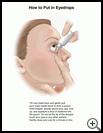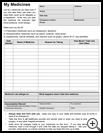
Carteolol, Ophthalmic
KAR-tee-oh-lol
________________________________________________________________________
KEY POINTS
- This medicine is used in the eyes to treat high pressure in the eyes. Use it exactly as directed.
- You will need to have regular eye pressure exams. Keep all appointments for these exams.
- This medicine may cause unwanted side effects. Tell your healthcare provider if you have any side effects that are serious, continue, or get worse.
- Tell all healthcare providers who treat you about all the prescription medicines, nonprescription medicines, supplements, natural remedies, and vitamins that you take.
________________________________________________________________________
What are other names for this medicine?
Type of medicine: beta blocker (ophthalmic)
Generic and brand names: carteolol, ophthalmic
What is this medicine used for?
This medicine (in the form of eyedrops) is used to treat high pressure in the eyes. High pressure in the eyes happens with glaucoma and other conditions.
This medicine may be used to treat other conditions as determined by your healthcare provider.
What should my healthcare provider know before I take this medicine?
Before taking this medicine, tell your healthcare provider if you have ever had:
- An allergic reaction to any medicine
- Asthma or other lung problems
- Diabetes
- Heart failure, a slow heartbeat, or heart rhythm problems
- High blood pressure
- Myasthenia gravis or other muscle disorders
- Thyroid problems
Females of childbearing age: Tell your healthcare provider if you are pregnant or plan to become pregnant. It is not known whether this medicine will harm an unborn baby. Do not breast-feed while taking this medicine without your healthcare provider's approval.
How do I use it?
Check the label on the medicine for directions about your specific dose. Use this medicine exactly as your healthcare provider prescribes. Do not use more of it or use it more often than prescribed. Using this medicine too much may increase the risk of side effects.
Check with your healthcare provider before using this medicine in children under age 18.
Wash your hands thoroughly before applying medicine to your eyes. Shake the medicine well before using. Tilt your head back and gently pull your lower eyelid down to form a pouch. Hold the dropper directly above your eye, look up, and squeeze a drop of the medicine into the pouch. Close your eyes for a minute or two and with a fingertip press gently on the inside corner of your eye to keep the medicine from draining out. Do not rub your eyes.
To avoid contaminating the medicine, do not let the tip of the dropper touch your eye or any other surface. After use, put the cap on tightly.
If you wear contact lenses, take them out before putting this medicine in your eyes. Wait at least 15 minutes after using this medicine before you put the contact lenses back in.
What if I miss a dose?
If you miss a dose, use it as soon as you remember unless it is almost time for the next scheduled dose. In that case, skip the missed dose and use the next one as directed. Do not use double doses. If you are not sure of what to do if you miss a dose, or if you miss more than one dose, contact your healthcare provider.
What if I overdose?
If you or anyone else has intentionally taken too much of this medicine, call 911 or go to the emergency room right away. If you pass out, have seizures, weakness or confusion, or have trouble breathing, call 911. If you think that you or anyone else may have taken too much of this medicine, call the poison control center. Do this even if there are no signs of discomfort or poisoning. The poison control center number is 800-222-1222.
Symptoms of an acute overdose may include: chest pain, dizziness, fainting, headache, shortness of breath, slow or irregular heartbeat, sweating, tremors, weakness, wheezing.
What should I watch out for?
This medicine may cause blurred vision for a few minutes. Do not drive or operate machinery until you can see clearly.
This product may make your eyes more sensitive to light. It helps to stay out of bright light and wear sunglasses.
You will need to have regular eye pressure exams. Keep all appointments for these exams.
If you need emergency care, surgery, lab tests, or dental work, tell the healthcare provider or dentist you are using this medicine. Ask your healthcare provider if you should continue to use this medicine if you injure your eye, get an eye infection, or need eye surgery.
If you have diabetes and take insulin, this medicine may affect your blood sugar levels. Also, it may be harder to tell if your blood sugar level is too low. Talk to your healthcare provider about this. Be sure you understand how this medicine might affect you and what to do if you have a problem.
What are the possible side effects?
Along with its needed effects, your medicine may cause some unwanted side effects. Some side effects may be very serious. Some side effects may go away as your body adjusts to the medicine. Tell your healthcare provider if you have any side effects that continue or get worse.
Life-threatening (Report these to your healthcare provider right away. If you cannot reach your healthcare provider right away, get emergency medical care or call 911 for help.): Allergic reaction (hives; itching; rash; trouble breathing; tightness in your chest; swelling of your lips, tongue, and throat).
Serious (Report these to your healthcare provider right away.): Redness, warmth, pus in your eye; extreme eye irritation; sensitivity to light; swelling of the eyelids, skin around your eyes, or lips; swelling in your legs, ankles, or feet; vision problems; dizziness; slow or irregular heartbeat; depression; confusion; severe weakness.
Other: Burning, stinging, red, or watery eyes; dry mouth; sore tongue; headache; feeling that something is in the eye; tiredness; drowsiness; trouble sleeping; blurred vision; headache; change in sense of smell; bitter or sour taste; nausea; anxiety; nasal dryness.
What products might interact with this medicine?
When you take this medicine with other medicines, it can change the way this or any of the other medicines work. Nonprescription medicines, vitamins, natural remedies, and certain foods may also interact. Using these products together might cause harmful side effects. Talk to your healthcare provider if you are taking:
- ACE inhibitors such as benazepril (Lotensin), captopril, enalapril (Vasotec), fosinopril, lisinopril (Prinivil, Zestril), quinapril (Accupril), and ramipril (Altace)
- Angiotensin receptor blockers (ARBs) such as azilsartan (Edarbi), candesartan (Atacand), eprosartan (Teveten), irbesartan (Avapro), losartan (Cozaar), olmesartan (Benicar), telmisartan (Micardis), and valsartan (Diovan)
- Beta blockers such as acebutolol (Sectral), atenolol (Tenormin), carvedilol (Coreg), labetalol (Trandate), metoprolol (Lopressor, Toprol), nadolol (Corgard), pindolol, and sotalol (Betapace, Sorine)
- Calcium channel blockers such as diltiazem (Cardizem, Cartia, Tiazac), felodipine, isradipine (DynaCirc), nicardipine (Cardene), nifedipine (Adalat CC, Procardia), and verapamil (Calan, Covera, Verelan)
- Carbonic anhydrase inhibitors such as acetazolamide (Diamox) and methazolamide (Neptazane)
- Clonidine (Catapres, Kapvay)
- Diabetes medicines such as glipizide (Glucotrol), glyburide (Glynase), insulin, metformin (Fortamet, Glucophage, Riomet), pioglitazone (Actos), repaglinide (Prandin), and rosiglitazone (Avandia)
- Digoxin (Lanoxin)
- Diuretics (water pills) such as bumetanide, chlorthalidone, furosemide (Lasix), hydrochlorothiazide (Microzide), indapamide, metolazone (Zaroxolyn), and triamterene/hydrochlorothiazide (Dyazide, Maxzide)
- Methyldopa
- Other products in your eyes (Do not use other products in your eyes while you are using this medicine without your healthcare provider's approval.)
- Propranolol (Hemangeol, Inderal, InnoPran)
- Reserpine
If you are not sure if your medicines might interact, ask your pharmacist or healthcare provider. Keep a list of all your medicines with you. List all the prescription medicines, nonprescription medicines, supplements, natural remedies, and vitamins that you take. Be sure that you tell all healthcare providers who treat you about all the products you are taking.
How should I store this medicine?
Store this medicine at room temperature. Keep the container tightly closed. Protect it from heat, high humidity, and bright light.
This advisory includes selected information only and may not include all side effects of this medicine or interactions with other medicines. Ask your healthcare provider or pharmacist for more information or if you have any questions.
Ask your pharmacist for the best way to dispose of outdated medicine or medicine you have not used. Do not throw medicine in the trash.
Keep all medicines out of the reach of children.
Do not share medicines with other people.
Last modified: 2016-09-22
Last reviewed: 2015-04-28


